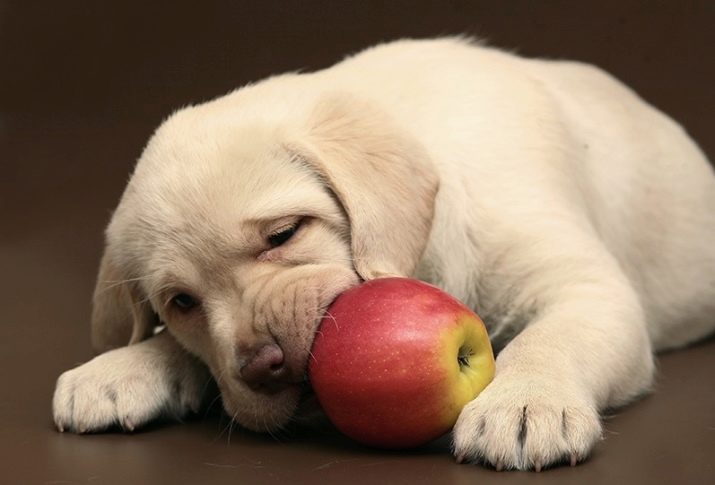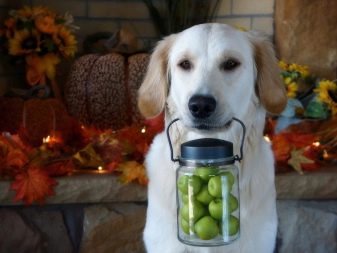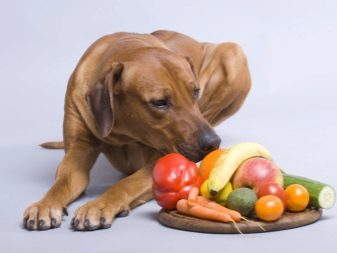Whether to allow a pet to eat apples is a question that rarely arises in advance. Usually, for the first time, the owner thinks about this immediately after the dog has already stole an apple. And what will happen to her, and will something unpleasant happen? No, it will not happen. You can give apples to dogs, but in certain quantities.

How does the fruit affect?
Much, of course, depends on the breed of the dog, age and state of its health. There are such pampered four-legged allergy sufferers that fruits cannot tolerate in principle. But most of the dogs living in our latitudes may well eat apples traditional for Russia. Moreover, this fruit should be considered optimal for the introduction of useful vitamin feeding to puppies.
Apples are pectin, the main vitamins, iron, manganese, potassium and magnesium, it is also light carbohydratesthat are needed to ensure that your four-legged friend’s body has a normal supply of energy. The vitamin composition of apples increases immunity, fiber improves digestion. And even dogs with “capricious” digestion (for example, pugs and sharpei) begin to go to the toilet “like clockwork”, constipation disappears. The animal feels good, it is energetic and healthy.
If a dog doesn’t gnaw, but a whole apple, then this is an excellent prevention of problems with gums and teeth. If you train a dog to eat apples, then you can safely cause the dog obesity to pamper the animal with a delicious light treat.
Dogs usually like apples.


When can fruit harm?
The answer to this question is quite simple and obvious - if there are too many apples. On a fruit diet, your four-legged pet will not last long. He needs a balanced diet, in which fruit is not the basis of the diet, but only a pleasant addition.
If you give the dog too many apples, then fiber that is useful for the intestines in moderation can lead to diarrhea, leaching of nutrients from the intestines, hypovitaminosis, digestive disorders, and pathological weight loss of the animal. Fermentation occurs in the intestines, flatulence increases.
Dog allergies usually do not occur, but breeds of high allergic status may show signs of an inadequate immune response. - the dog starts to itch, there are problems with digestion. Experts are inclined to believe that the reason lies not in the fruit itself, but in the chemicals that often peel, if the yard is out of season, if the apples are imported. Does it mean that in the winter you can’t give apples to the dog? No, it doesn’t. You just need to peel and give fruit without it.

How to give?
If you give the dog an apple for the first time, do not rush to make the pet happy in large portions. Limit yourself to a small piece, observe whether the pet loves the taste, whether he likes the allergic reaction. Treat the fruit after the dog has eaten his main meal.
Green and yellow fresh apples are suitable for dog food. If your fruits grown in your garden or at least in your strip, you can give them with a peel. If purchased and imported, it is better to free the fruit from the peel.
What is better for the dog to protect from is apple seeds. They contain cyanide, a toxic compound. And if the pet likes to eat hastily, literally swallows the offered slices indiscriminately, it is better to cut the fruit into cubes so that your four-legged friend does not choke in a hurry.
Not all dogs willingly and enthusiastically take the apples offered.
If the delicacy was not liked and did not cause interest in the animal, mix small pieces or a grated apple with a product that your dog respects, for example, with cottage cheese, porridge.

Small dogs need fruit a little more than large dogs. The total share of fruits and vegetables in the diet of small breeds should be about 45%, and for large dogs - no more than 30%. In order not to make a mistake with the quantity and not harm the health of the pet, remember:
a dog weighing up to 10 kilograms is given no more than half an apple 2 times a week;
an average dog from 10 to 25 kilograms in weight is given a whole apple three times a week;
Large dogs (over 26 kilograms in weight) can be offered 1 apple twice a week.
It is permissible to give apples to litter puppies in grated and chopped form, you can start at the age of 2.5 months. A puppy can be offered an apple supplement in the diet once a day every day or every other day (in reasonable, naturally, quantities). It can be easier to feed apples to pregnant dogs, even if before the onset of pregnancy the female dog did not burn with great love for these fruits. Like people, the taste preferences of the dog change during the period of gestation, the need for vitamins increases, and the dog gladly satisfies it by absorbing an apple, pear, bananas.
If you have the opportunity to collect the so-called wild apples for your dog, do it without fail. According to their characteristics, they are much better and more useful than cultivars.
Wild apples used to be picked and given to guard dogs. There is a minus - they are more acidic, and not every dog will agree to eat such fruits.


In what form can a treat be offered?
You can give apples to dogs in almost any form - baked, fresh, and some dogs really like soaked apples. Dried apples are often included in vitamin mixtures and animal feed.And if the dog insistently refuses to eat a fresh apple, try to offer him dried fruit - there is a chance that he will have a taste for taste.
Do not give dogs apple jam, sweet apple compote, apple jam. All dishes in which in addition to fruit there is a large amount of sugar for the dog is not useful, but destructive. But if you make a compote of apples without sugar, then the dog can be offered a small portion - as a variety.

How to understand that the dog has become ill from apples, what should I do?
If the fruit nevertheless caused a negative reaction, then it will be easy to recognize it: the pet has itchy skin, the dog itches. Eyes may begin to watery, sometimes it “flows” from the nose. In dogs prone to allergies, hair loss quickly begins. If this happens, do not waste time looking for a product that caused such a reaction, immediately help a friend.
Like people with allergic sensitization, dogs are given antihistamines (Suprastin, Loratadin, Erius, etc.). Give the dosage in accordance with the instructions for the drug, which describes the dose and frequency for children. If the dog is small, halve the infant dose.
After first aid, consult your veterinarian. Remember everything that the dog ate during the last day. Sometimes an allergy does not even develop on products, but, for example, on a new rubber ball. Prior to seeing a doctor, do not give your dog anything that could aggravate the negative reaction. Provide your dog a plentiful drink - this will help to quickly remove antigen residues from the body.
If the dog suffocates after the apple, lets the foam out of his mouth, it is possible that cyanide poisoning occurred (from the bones, if the dog got to the bucket, where they cleaned the stubs while cooking the jam). Take your dog to a doctor right away. You yourself cannot help her.

Can I replace the product?
Infused with the potential benefits of this fruit, the owner can offer apples to the dog, but for some reason the dog will refuse to treat him in any way. In this case, the question arises, how to replace the product? The answer is simple - with any other fruit. Offer the dog a pear, a banana, a piece of melon. Sometimes dogs don’t like fruit at all. Such animals should try to offer vegetables, for example, pumpkin or carrots.


Apples are not a must-have dog food. But it will be better for everyone if they are still present in the permitted amount. The easiest way to train a dog is to eat them in childhood.
What fruits can be given to dogs, see the video below.









































